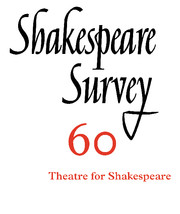Book contents
- Frontmatter
- Professional Players in the Guild Hall, Stratford-upon-Avon, 1568–1597
- Reconstructing The Rose: Development of the Playhouse Building between 1587 and 1592
- The Rose and its Stages
- Philip Henslowe and the Elizabethan Court
- From Revels to Revelation: Shakespeare and the Mask
- Bride-ing the Shrew: Costumes that Matter
- ‘When Men and Women are Alone’: Framing the Taming in India
- The Crown and the Pillow: Royal Properties in Henry IV
- Humanity at Stake: Man and Animal in Shakespeare’s Theatre
- Popular Shakespeare in Japan
- ‘Philosophy in a Gorilla Suit’: Do Shakespearians Perform or Just Perform-a-tive?
- Sudokothellophobia: Writing Hypertextually, Performatively
- Living Monuments: The Spatial Politics of Shakespeare’s Rome on the Contemporary Stage
- ‘In Windsor Forest and at the Boar’s Head’: The ‘Falstaff Plays’ and English Music in the Early Twentieth Century
- Michael Bogdanov in Conversation
- The Mouse and the Urn: Re-Visions of Shakespeare from Voltaire to Ducis
- ‘I covet your skull’: Death and Desire in Hamlet
- Martin Droeshout Redivivus: Reassessing the Folio Engraving of Shakespeare
- Canonizing Shakespeare: The Passionate Pilgrim, England’s Helicon and the Question of Authenticity
- Rereading Shakespeare: The Example of Richard Brathwait
- Shakespeare Performances in England, 2006: January 2006
- Professional Shakespeare Productions in the British Isles January–December 2005
- he Year's Contributions to Shakespearian Study 1 Critical Studies
- 2 Shakespeare in Performance
- 3 Editions and Textual Studies
- Index
Martin Droeshout Redivivus: Reassessing the Folio Engraving of Shakespeare
Published online by Cambridge University Press: 28 November 2007
- Frontmatter
- Professional Players in the Guild Hall, Stratford-upon-Avon, 1568–1597
- Reconstructing The Rose: Development of the Playhouse Building between 1587 and 1592
- The Rose and its Stages
- Philip Henslowe and the Elizabethan Court
- From Revels to Revelation: Shakespeare and the Mask
- Bride-ing the Shrew: Costumes that Matter
- ‘When Men and Women are Alone’: Framing the Taming in India
- The Crown and the Pillow: Royal Properties in Henry IV
- Humanity at Stake: Man and Animal in Shakespeare’s Theatre
- Popular Shakespeare in Japan
- ‘Philosophy in a Gorilla Suit’: Do Shakespearians Perform or Just Perform-a-tive?
- Sudokothellophobia: Writing Hypertextually, Performatively
- Living Monuments: The Spatial Politics of Shakespeare’s Rome on the Contemporary Stage
- ‘In Windsor Forest and at the Boar’s Head’: The ‘Falstaff Plays’ and English Music in the Early Twentieth Century
- Michael Bogdanov in Conversation
- The Mouse and the Urn: Re-Visions of Shakespeare from Voltaire to Ducis
- ‘I covet your skull’: Death and Desire in Hamlet
- Martin Droeshout Redivivus: Reassessing the Folio Engraving of Shakespeare
- Canonizing Shakespeare: The Passionate Pilgrim, England’s Helicon and the Question of Authenticity
- Rereading Shakespeare: The Example of Richard Brathwait
- Shakespeare Performances in England, 2006: January 2006
- Professional Shakespeare Productions in the British Isles January–December 2005
- he Year's Contributions to Shakespearian Study 1 Critical Studies
- 2 Shakespeare in Performance
- 3 Editions and Textual Studies
- Index
Summary
Among the most familiar portraits of Shakespeare is the engraving that graces the title-page of the 1623 First Folio of Shakespeare’s plays (see illustration). Unlike other portraits purporting to be the playwright, the engraving should present no question of authenticity, for the publication date establishes its terminus ab quo and Ben Jonson’s attendant verses lament the ‘Sweet Swan of Avon’ and note the figure ‘was for gentle Shakespeare cut’. Nor is the engraver’s name in question, for below the portrait is his signature: ‘Martin Droeshout Sculpsit London’. Droeshout engraving of Shakespeare on the title-page of the 1623 First Folio, signed in London.
But there are two Martin Droeshouts in the records of early modern London, and the question of which of them engraved the famous title-page has not been settled. Was it the elder Martin, who was born in Brussels but spent much of his life in London? Or was it his nephew, who was born in London in 1601? The London records mention the elder several times, identifying him as the son of John Droeshout, a painter, and brother of Michael, an engraver; he himself is called a painter. The younger is mentioned only once, upon his baptism; but there are several references to his father, Michael, and his older brother, John, who were both engravers.
In 1991, following years of uncertainty and assumption, two articles provided new evidence on the Droeshouts. But the evidence was of two kinds, and the authors came to opposite conclusions: Mary Edmond contended that the elder Martin was the likely engraver of Shakespeare; Christiaan Schuckman believed it was the younger.
- Type
- Chapter
- Information
- Shakespeare Survey , pp. 237 - 251Publisher: Cambridge University PressPrint publication year: 2007



